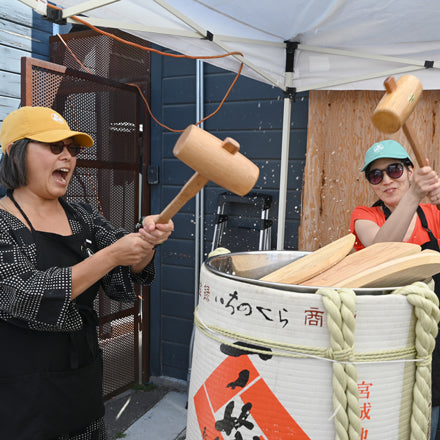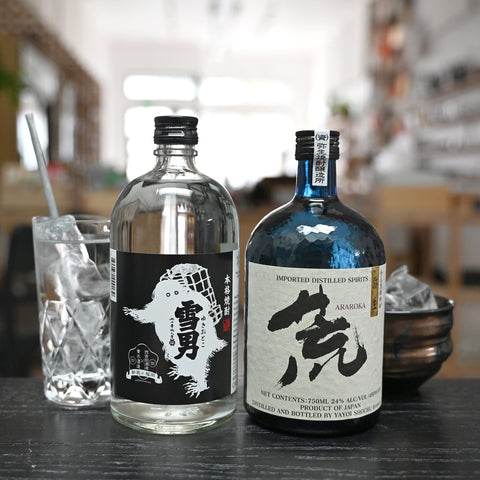 This month’s bottles: Kisoji Sanwari + Kirei 89
This month’s bottles: Kisoji Sanwari + Kirei 89
Hello again, I’m back for another month of koji exploration. Who’s coming with me
This month’s theme was again inspired by our visit to Matsuse Shuzo in February, where Yoko and I were able to taste their Yamada Nishiki kojimai! It was sweet like mochi, earthy, slightly floral, with a gummy texture. I wondered, what does koji taste like in sake?
Here we are in September, where I’ve chosen two bottles that may represent the flavors of koji – precisely because they are made with more koji than what brewers usually use for their sakes (the minimum required by law is 15%). Toji Masahiro Nishigaki of Kirei Shuzo says, “The quality of the koji affects the taste of the sake. Good koji is necessary for good sake brewing.” His brew Kirei Hachiku uses 89% of koji!
For a broader perspective, Naoko Yukawa, director of Yukawa Brewery tells us, “Of course, koji is not the only important factor, but other factors such as the balance between saccharification and fermentation (what kind of flavor do you want to create), the speed of fermentation (whether it makes it savory or sweet), and the composition of flavor components (the composition of acids and amino acids) are essential elements in designing a product concept.” That said, Yukawa’s bottle of Sanwari Koji consists of one third koji, which highlights the importance of koji in a not-so-subtle manner.
Thank you for joining me on this wild koji ride these last two months. Both sakes this month, in its abundance of koji, exhibit juicy sweetness, deep umami, and divine acidity. My conclusion is that koji is magic. I hope you dig it!
Kanpai,
Kayoko (Co-Founder + Shochu Director, Umami Mart)
SILVER + GOLD

Kirei Hachiku Junmai Muroka Nama Genshu
Kirei Shuzo (Hiroshima)
Seimaibuai 70% Nakasei Shinsenbon (kojimai + kakemai)
SMV: -18, Acidity: 3.3, Koji cultivation time: 72 hours
Made with 89% koji – using a five-stage moromi process instead of the usual thre – this bold junmai packs a punch full of acidity, depth, and vitality! Toji Nishigaki-san explained that he uses so much koji for this sake to, “bring out the full flavor of the sake.”
We enlisted Fifth Taste Sake Importer Jesse Pugach to break it down for us: “Higher levels of koji mean higher levels of enzymes and a higher rate of converting starches into sugars and proteins into amino acids. The five stage moromi means that there is a greater buildup of sugars and enzymes. All of this leads to a sake high in sweetness and umami, but balanced by high acidity. In order to further balance it, they leave it as genshu, so the slightly higher alcohol carries the flavor and it does not feel heavy.”
This sake is nothing if not complex. At once you’ll be reminded of a soft earthy cheese, jasmine blossoms on a warm night, and rum raisin ice cream. Drink on the rocks with lamb kababs, KBBQ, and tonkatsu. Try adding it to a Bamboo cocktail as a sherry alternative!

Kisoji Sanwari Koji Junmai
Yukawa Sake Brewery (Nagano, Japan)
Seimaibuai: 70% Hitogokochi (kojimai + kakemai)
SMV + Acidity: Undisclosed, Koji cultivation time: 52 hours
Aged for 6 months to a year
The inspiration for this sake was old brewing recipes from the Meiji period, when the proportions of koji were higher. President Yukawa says, “Currently, we are making sake that makes the most of the use of a large amount of koji in order to achieve a richer and more complex flavor concept.”
If Kirei Hachiku is punk rock, Kisoji is its classical cousin. It drinks elegantly chilled as an aperitif, with notes of green apple, dates, and maple syrup. For the main course, enjoy room temperature with buttermilk roasted chicken; and chocolate cake for dessert. Dre suggests sipping on this sake with a bowl of nuts!
 President Naoko Yugawa making koji at Yukawa Brewery
President Naoko Yugawa making koji at Yukawa Brewery




Comments (0)
There are no comments for this article. Be the first one to leave a message!